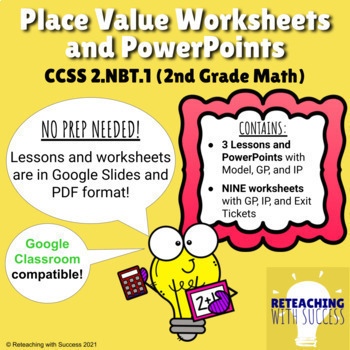2nd Grade Place Value NO PREP Worksheets and Powerpoint 2.NBT.A.1 (Digital)
Mathniverse
166 Followers
Grade Levels
1st - 3rd, Homeschool
Subjects
Resource Type
Standards
CCSS2.NBT.A.1
CCSS2.NBT.A.1a
Formats Included
- Google Drive™ folder
- Easel Assessment
Pages
58 pages
Mathniverse
166 Followers

Made for Google Drive™
This resource can be used by students on Google Drive or Google Classroom. To access this resource, you’ll need to allow TPT to add it to your Google Drive. See our FAQ and Privacy Policy for more information.
Easel Assessment Included
This resource includes a self-grading quiz students can complete on any device. Easel by TPT is free to use! Learn more.
Also included in
- Are your students having difficulty with concepts such as place value, skip counting expanded form, comparing numbers? This bundle includes lessons, PowerPoints, and activities that teach different strategies to help your students both understand and practice these tricky math concepts! These lessonPrice $18.00Original Price $23.00Save $5.00
Description
Do your students need extra practice with CCSS 2.NBT.A.1 and understanding hundreds, tens, and ones? Are they having trouble bundling tens together to make a hundred or breaking down a number into different units? This worksheet + PowerPoint combo is the resource for you!
Why does this resource stand out?
- THREE LESSONS in PowerPoint/Google Slides format
- Scaffolds learning how to break apart 2-digit first and then later how to break apart 3-digit numbers
- Pushes academic rigor by showing students how to solve different types of 2.NBT.A.1 problems
- Some Google Slides are EDITABLE and can be typed in directly while teaching
- Includes teacher guide
- Lesson Objectives include:
- Lesson 1 Objective - Students will be able to count to 100 by bundling ones into tens and tens into hundreds.
- Lesson 2 Objective - Students will be able to break down a three-digit number into hundreds, tens, and ones by thinking about each of the units (hundred, tens, and ones)
- Lesson 3 Objective - Students will be able to break down a three-digit number into hundreds, tens, and ones by thinking about each of the units (hundred, tens, and ones)
- Each lesson takes around 20-30 minutes to go through the Model, Guided Practice, and Independent Practice depending on the level of your students
- NINE WORKSHEETS that can be easily uploaded to Google Classroom
- Each lesson includes a Guided Practice, Independent Practice, and Exit Ticket worksheet that align with the PowerPoint lesson
- Exit Ticket allows you to do a quick assessment of your student's understanding
- Worksheet topics include:
- Bundling units to create a new unit (ex: 10 ones = 1 ten)
- Finding the value of a digit in a 2-digit and 3-digit number
- Finding the value of a 2-digit and 3-digit number in base ten blocks
- Writing the value when given a unit
- Showing a 2-digit and 3-digit number in different ways using base ten blocks, units, and more
- INCLUDES EASEL ASSESSMENT to help determine what misconceptions your students have
Need place value anchor charts? Click here!
Looking for more math resources?
Check out our TpT store!
Got questions or feedback? We'd love to hear from you!
reteachingwithsuccess@gmail.com
Did you know that you can receive credit towards future TpT purchases by reviewing this resource? If you enjoy this resource, please leave a review on the product page or through “My Purchases” at TpT.
Total Pages
58 pages
Answer Key
Included
Teaching Duration
N/A
Last updated Jul 2nd, 2021
Report this resource to TPT
Reported resources will be reviewed by our team. Report this resource to let us know if this resource violates TPT’s content guidelines.
Standards
to see state-specific standards (only available in the US).
CCSS2.NBT.A.1
Understand that the three digits of a three-digit number represent amounts of hundreds, tens, and ones; e.g., 706 equals 7 hundreds, 0 tens, and 6 ones. Understand the following as special cases:
CCSS2.NBT.A.1a
100 can be thought of as a bundle of ten tens - called a “hundred.”






